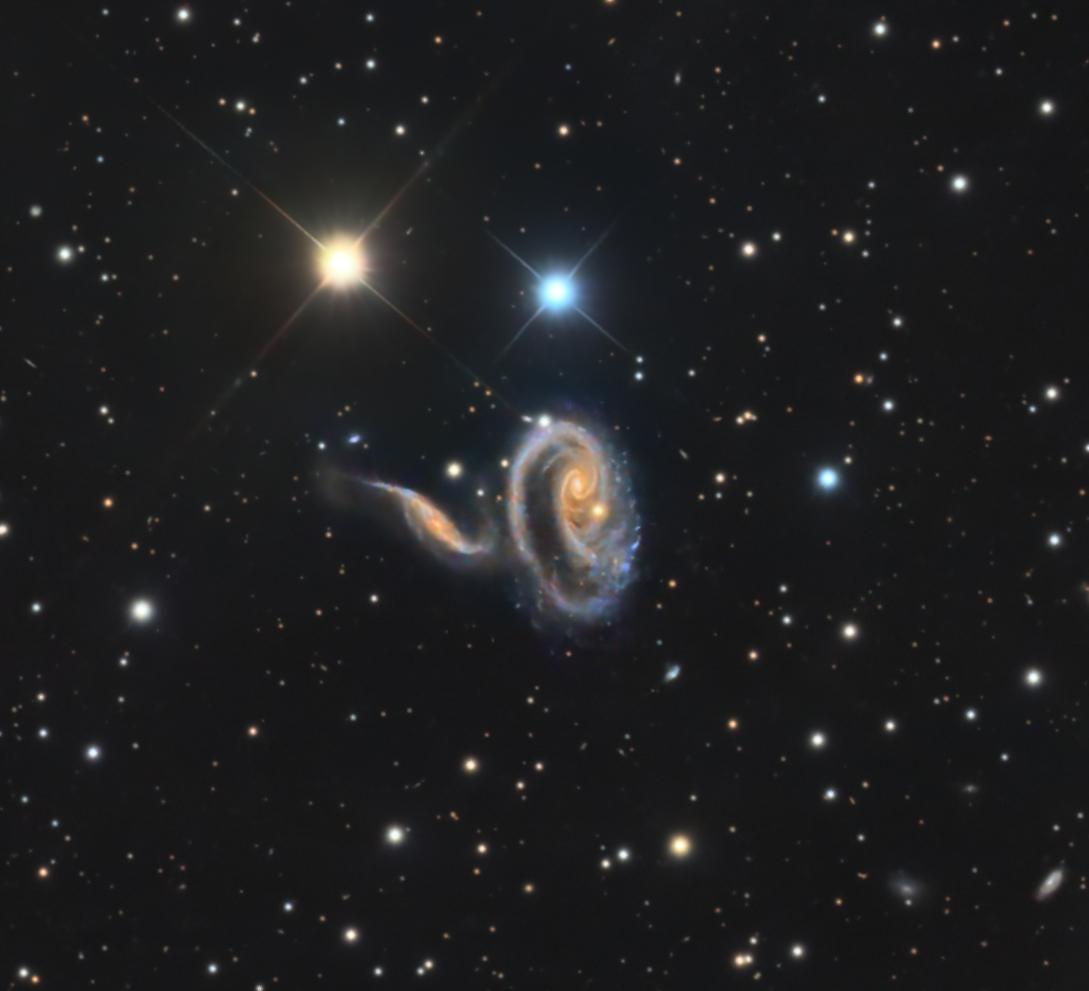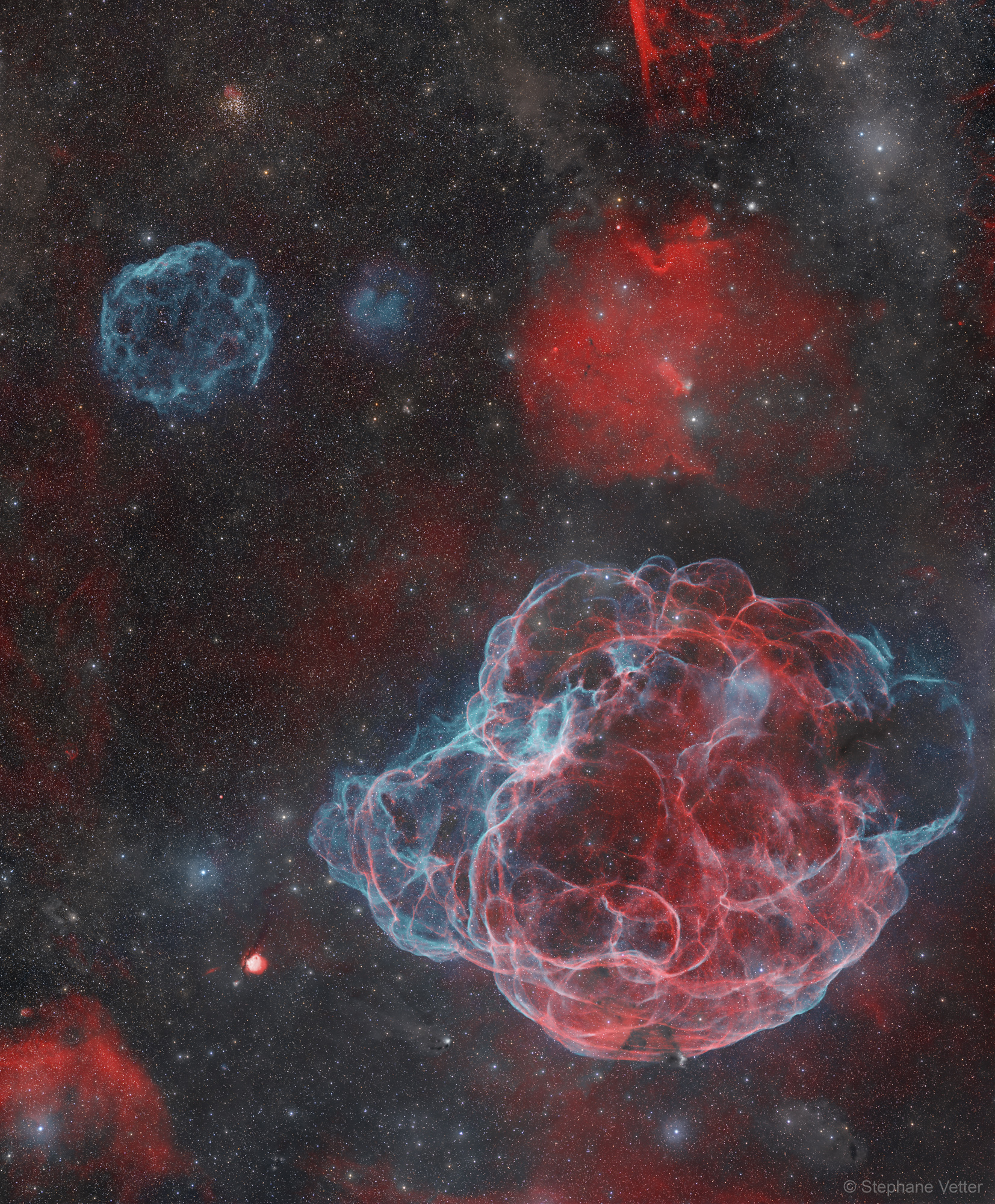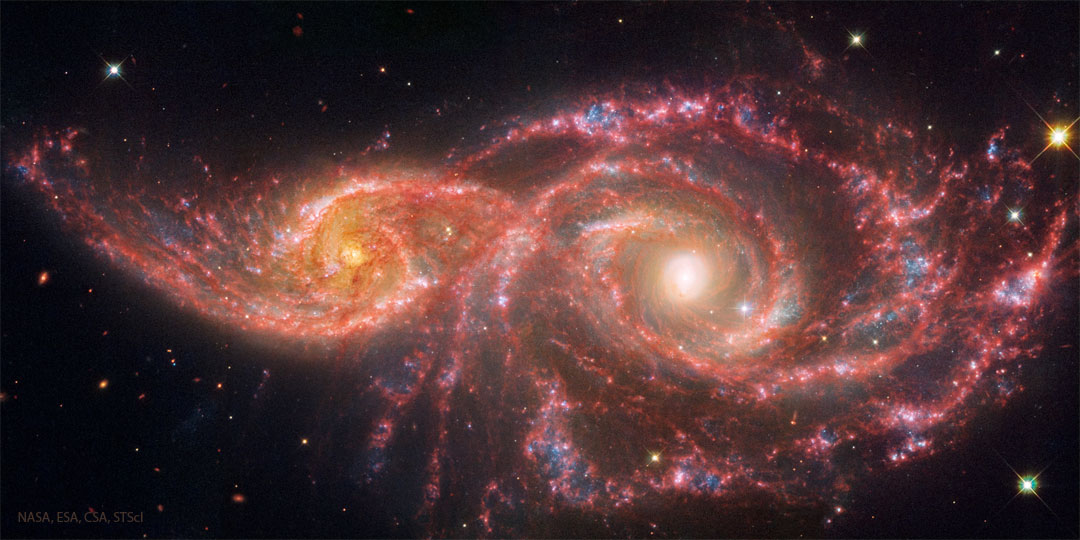Blog
The colorful, spiky stars are in the foreground of this image taken with a small telescope on planet Earth. They lie well within our own Milky Way Galaxy. But the two eye-catching galaxies in the frame lie far beyond the Milky Way, at a distance of over 300 million light-years. The galaxies’ twisted and distorted appearance is due to mutual gravitational tides as the pair engage in close encounters. Cataloged as Arp 273 (also as UGC 1810), these galaxies do look peculiar, but interacting galaxies are now understood to be common in the universe. Closer to home, the large spiral Andromeda Galaxy is known to be some 2 million light-years away and inexorably approaching the Milky Way. In fact the far away peculiar galaxies of Arp 273 may offer an analog of the far future encounter of Andromeda and Milky Way. Repeated galaxy encounters on a cosmic timescale ultimately result in a merger into a single galaxy of stars.From our perspective, the bright cores of the Arp 273 galaxies are separated by only a little over 100,000 light-years.

James Patrick Page OBE (born 9 January 1944) is an English musician and producer who achieved international success as the guitarist and founder of the rock band Led Zeppelin. Prolific in creating guitar riffs, Page’s style involves various alternative guitar tunings and melodic solos, coupled with aggressive, distorted guitar tones. It is also characterized by his folk and eastern-influenced acoustic work. He is notable for occasionally playing his guitar with a cello bow to create a droning sound texture to the music.
Page began his career as a studio session musician in London and, by the mid-1960s, alongside Big Jim Sullivan, was one of the most sought-after session guitarists in Britain. He was a member of the Yardbirds from 1966 to 1968. When the Yardbirds broke up, he founded Led Zeppelin, which was active from 1968 to 1980. Following the death of Led Zeppelin drummer John Bonham, he participated in a number of musical groups throughout the 1980s and 1990s, more specifically XYZ, the Firm, the Honeydrippers, Coverdale–Page, and Page and Plant. Since 2000, Page has participated in various guest performances with many artists, both live and in studio recordings, and participated in a one-off Led Zeppelin reunion in 2007 that was released as the 2012 concert film Celebration Day. Along with the Edge and Jack White, he participated in the 2008 documentary It Might Get Loud.
Page is widely considered to be one of the greatest and most influential guitarists of all time. Rolling Stone magazine has described Page as “the pontiff of power riffing” and ranked him number three in their 2015 list of the “100 Greatest Guitarists of All Time”, behind Jimi Hendrix and Eric Clapton, and ranking 3rd again in 2023 behind Chuck Berry and Jimi Hendrix. In 2010, he was ranked number two in Gibson‘s list of “Top 50 Guitarists of All Time” and, in 2007, number four on Classic Rock‘s “100 Wildest Guitar Heroes”. He was inducted into the Rock and Roll Hall of Fame twice: once as a member of the Yardbirds (1992) and once as a member of Led Zeppelin (1995).
more...Joan Chandos Baez ( born January 9, 1941) is an American singer, songwriter, musician, and activist. Her contemporary folk musicoften includes songs of protest and social justice. Baez has performed publicly for over 60 years, releasing more than 30 albums.
Baez is generally regarded as a folk singer, but her music has diversified since the counterculture era of the 1960s and encompasses genres such as folk rock, pop, country, and gospel music. She began her recording career in 1960 and achieved immediate success. Her first three albums, Joan Baez, Joan Baez, Vol. 2 and Joan Baez in Concert, all achieved gold record status. Although a songwriter herself, Baez generally interprets others’ work, having recorded many traditional songs and songs written by the Allman Brothers Band, the Beatles, Jackson Browne, Leonard Cohen, Woody Guthrie, Violeta Parra, the Rolling Stones, Pete Seeger, Paul Simon, Stevie Wonder, Bob Marley, and many others. She was one of the first major artists to record the songs of Bob Dylan in the early 1960s; Baez was already an internationally celebrated artist and did much to popularize his early songwriting efforts. Her tumultuous relationship with Dylan later became the subject of songs from both and generated much public speculation. On her later albums she has found success interpreting the work of more recent songwriters, including Ryan Adams, Josh Ritter, Steve Earle, Natalie Merchant, and Joe Henry.
Baez’s acclaimed songs include “Diamonds & Rust” and covers of Phil Ochs‘s “There but for Fortune” and the Band‘s “The Night They Drove Old Dixie Down“. She is also known for “Farewell, Angelina“, “Love Is Just a Four-Letter Word“, “Forever Young“, “Here’s to You“, “Joe Hill“, “Sweet Sir Galahad” and “We Shall Overcome“. Baez performed fourteen songs at the 1969 Woodstock Festival and has displayed a lifelong commitment to political and social activism in the fields of nonviolence, civil rights, human rights, and the environment. Baez was inducted into the Rock and Roll Hall of Fame on April 7, 2017.
more...John Paul “Bucky” Pizzarelli (January 9, 1926 – April 1, 2020 Paterson, NJ) was an American jazz guitarist.
He was the father of jazz guitarist John Pizzarelli and double bassist Martin Pizzarelli. He worked for NBC as a staffman for Dick Cavett (1971) and ABC with Bobby Rosengarden in (1952). Musicians he collaborated with include Benny Goodman, George Barnes, Les Paul, Oscar Peterson, Stéphane Grappelli, Benny Green, and Antônio Carlos Jobim. Pizzarelli cited as influences Django Reinhardt, Freddie Green, and George Van Eps.
more...Kenneth Clarke Spearman (January 9, 1914 – January 26, 1985), known professionally as Kenny Clarke and nicknamed Klook, was an American jazz drummer and bandleader. A major innovator of the bebop style of drumming, he pioneered the use of the ride cymbal to keep time rather than the hi-hat, along with the use of the bass drum for irregular accents (“dropping bombs”).
Born in Pittsburgh, Pennsylvania, he was orphaned at the age of about five and began playing the drums when he was eight or nine on the urging of a teacher at his orphanage. Turning professional in 1931 at the age of seventeen, he moved to New York City in 1935 when he began to establish his drumming style and reputation. As the house drummer at Minton’s Playhouse in the early 1940s, he participated in the after-hours jams that led to the birth of bebop. After military service in the US and Europe between 1943 and 1946, he returned to New York, but from 1948 to 1951 he was mostly based in Paris. He stayed in New York between 1951 and 1956, performing with the Modern Jazz Quartet and playing on early Miles Davis recordings. He then moved permanently to Paris, where he performed and recorded with European and visiting American musicians and co-led the Kenny Clarke/Francy Boland Big Band between 1961 and 1972. He continued to perform and record until the month before he died of a heart attack in January 1985.
more...A huge fireball of hot gas shoots out in all directions. When this gas slams into the existing interstellar medium, it heats up so much it glows. Two different supernova remnants (SNRs) are visible in the featured image, taken at the Oukaïmeden Observatory in Morocco. The blue soccer ball-looking nebula toward the upper left is SNR G179.0+02.6, which appears to be the smaller one. This supernova, about 11,000 light years distant, detonated about 50,000 years ago. Although composed mostly of hydrogen gas, the blue light is emitted by a trace amount of oxygen. The seemingly larger SNR, dominating the lower right of the frame, is the Spaghetti Nebula, cataloged as Simeis 147 and sh2-240. This supernova, only about 3,000 light years away, exploded about 40,000 years ago. Comparatively, even though they appear different sizes, both supernova remnants are not only roughly the same age, but about the same size, too.

David Robert Jones (8 January 1947 – 10 January 2016), known professionally as David Bowie was an English singer, songwriter, musician and actor. Regarded as one of the most influential musicians of the 20th century, Bowie was acclaimed by critics and musicians, particularly for his innovative work during the 1970s. His career was marked by reinvention and visual presentation, and his music and stagecraft has had a significant impact on popular music.
Bowie developed an interest in music from an early age. He studied art, music and design before embarking on a professional career as a musician in 1963. He released a string of unsuccessful singles with local bands and a self-titled solo album (1967) before achieving his first top-five entry on the UK singles chart with “Space Oddity” (1969). After a period of experimentation, he re-emerged in 1972 during the glam rock era with the flamboyant and androgynous alter ego Ziggy Stardust. The character was spearheaded by the success of “Starman” and its album The Rise and Fall of Ziggy Stardust and the Spiders from Mars (both 1972), which won him widespread popularity. In 1975, Bowie’s style shifted towards a sound he characterised as “plastic soul“, initially alienating many of his UK fans but garnering his first major US crossover success with the number-one single “Fame” and the album Young Americans (both 1975). In 1976, Bowie starred in the cult film The Man Who Fell to Earth and released Station to Station. In 1977, he again changed direction with the electronic-inflected album Low, the first of three collaborations with Brian Eno that came to be known as the Berlin Trilogy. “Heroes” (1977) and Lodger (1979) followed; each album reached the UK top five and received lasting critical praise.
After uneven commercial success in the late 1970s, Bowie had three number-one hits: the 1980 single “Ashes to Ashes“, its album Scary Monsters (and Super Creeps) and “Under Pressure” (a 1981 collaboration with Queen). He achieved his greatest commercial success in the 1980s with Let’s Dance (1983). Between 1988 and 1992, he fronted the hard rock band Tin Machine before resuming his solo career in 1993. Throughout the 1990s and 2000s, Bowie continued to experiment with musical styles, including industrial and jungle. He also continued acting; his roles included Major Jack Celliers in Merry Christmas, Mr. Lawrence (1983), Jareth the Goblin King in Labyrinth(1986), Phillip Jeffries in Twin Peaks: Fire Walk with Me (1992), Andy Warhol in the biopic Basquiat (1996), and Nikola Tesla in The Prestige (2006), among other film and television appearances and cameos. He ceased touring after 2004 and his last live performance was at a charity event in 2006. He returned from a decade-long recording hiatus in 2013 with The Next Day and remained musically active until his death from liver cancer in 2016. He died two days after both his 69th birthday and the release of his final album, Blackstar.
During his lifetime, his record sales, estimated at over 100 million worldwide, made him one of the best-selling musicians of all time. He is the recipient of numerous accolades, including six Grammy Awards and four Brit Awards. Often dubbed the “chameleon of rock” due to his constant musical reinventions, he was inducted into the Rock and Roll Hall of Fame in 1996. Rolling Stone ranked him among the greatest singers, songwriters and artists of all time. As of 2022, Bowie was the best-selling vinyl artist of the 21st century.
more...Bill Graham (born Wulf Wolodia Grajonca; January 8, 1931 – October 25, 1991) was a German-born American impresario and rock concert promoter.
In the early 1960s, Graham moved to San Francisco, and in 1965, began to manage the San Francisco Mime Troupe. He had teamed up with local Haight Ashbury promoter Chet Helms to organize a benefit concert, then promoted several free concerts. This eventually turned into a profitable full-time career and he assembled a talented staff. Graham had a profound influence around the world, sponsoring the musical renaissance of the 1960s from its epicenter in San Francisco. Chet Helms and then Graham made famous the Fillmore and Winterland Ballroom; these turned out to be a proving grounds for rock bands and acts of the San Francisco Bay area including the Grateful Dead, Jefferson Airplane, and Big Brother and the Holding Company with Janis Joplin, who were first managed, and in some cases developed, by Helms.
more...Singer Jerome “Little Anthony” Gourdine was born on January 8, 1941, to Victoria Stafford and Thomas Elliot Gourdine. He grew up in the Fort Greene Housing Project in Brooklyn, New York, and attended Boys High School. While in high school, Gourdine and his friends created a doo-wop group called, “The Duponts.”
In 1957, Gourdine joined a new group called the, The Chesters, as the lead vocalist. The group recorded, “Tears on My Pillow,” which became an instant success. The Chesters, changed their name to Little Anthony & The Imperials, in 1959, and released their second hit single, “Shimmy, Shimmy, Ko-Ko-Bop,” which sold one million records.
Little Anthony & the Imperials reformed under DCP records in 1964. From 1964 through 1967, Little Anthony & The Imperials achieved success with songs like, “I’m Outside Looking In,” “Goin’ Out of My Head,” and “Hurt So Bad.” They appeared on the “The Ed Sullivan Show,” the “Kraft Music Hall Television Show,” and Dick Clark’s television specials. In 1969, Little Anthony & The Imperials signed with United Artists and recorded several chart singles. Gourdine left the group in 1975 to begin a sixteen year long acting and solo singing career.
Little Anthony & The Imperials performed their first reunion show in 1992, in New York City, New York. Over the years, they have had seventeen pop and twelve R&B chart hits.
Gourdine now resides in Las Vegas, Nevada with his wife, Linda.
Jerome “Little Anthony” Gourdine was interviewed by The HistoryMakers on April 6, 2007.
more...Dave Weckl (born January 8, 1960, in St. Louis, Missouri) is an American jazz fusiondrummer and the leader of the Dave Weckl Band. He was inducted into the Modern Drummer Hall of Fame in 2000.
Weckl started playing his first set of drums at age 8 in his spare room along with records. He later played in the living room, sometimes with his father on piano.Weckl studied at the University of Bridgeport. Starting out on the New York fusion scene in the early 1980s, Weckl soon began working with artists such as Paul Simon, George Benson, Michel Camilo, Robert Plant, and Anthony Jackson.
He was with the Chick Corea Elektric Band from 1985 to 1991. During this time he performed on many albums and also appeared with Corea’s Akoustic Band. He said he “augmented his work with Corea by continuing his session work and appearing often with the GRP All-Star Big Band“. Weckl has released a series of instructional videotapes. His first recording as leader was in 1990 – Master Plan, for GRP. This was followed by Heads Up in 1992, and Hard-Wired in 1994. Later on, Weckl recorded and toured with guitarist Mike Stern.
more...Elvis Aaron Presley (January 8, 1935 – August 16, 1977), known mononymously as Elvis, was an American singer and actor. Known as the “King of Rock and Roll“, he is regarded as one of the most significant cultural figures of the 20th century. Presley’s energized performances and interpretations of songs, and sexually provocativeperformance style, combined with a singularly potent mix of influences across color lines during a transformative era in race relations, brought both great success and initial controversy.
Presley was born in Tupelo, Mississippi; his family moved to Memphis, Tennessee when he was 13. His music career began there in 1954, at Sun Records with producer Sam Phillips, who wanted to bring the sound of African-American music to a wider audience. Presley, on guitar and accompanied by lead guitarist Scotty Moore and bassist Bill Black, was a pioneer of rockabilly, an uptempo, backbeat-driven fusion of country musicand rhythm and blues. In 1955, drummer D. J. Fontana joined to complete the lineup of Presley’s classic quartet and RCA Victor acquired his contract in a deal arranged by Colonel Tom Parker, who managed him for the rest of his career. Presley’s first RCA Victor single, “Heartbreak Hotel“, was released in January 1956 and became a number-one hit in the US. Within a year, RCA Victor would sell ten million Presley singles. With a series of successful television appearances and chart-topping records, Presley became the leading figure of the newly popular rock and roll; though his performative style and promotion of the then-marginalized sound of African Americans led to him being widely considered a threat to the moral well-being of white American youth.
In November 1956, Presley made his film debut in Love Me Tender. Drafted into military service in 1958, he relaunched his recording career two years later with some of his most commercially successful work. Presley held few concerts, and guided by Parker, proceeded to devote much of the 1960s to making Hollywood films and soundtrack albums, most of them critically derided. Some of Presley’s most famous films included Jailhouse Rock (1957), Blue Hawaii (1961), and Viva Las Vegas (1964). In 1968, he returned to the stage in the acclaimed NBC television comeback special Elvis, which led to an extended Las Vegas concert residency and a string of highly profitable tours. In 1973, Presley gave the first concert by a solo artist to be broadcast around the world, Aloha from Hawaii. Years of prescription drug abuse and unhealthy eating severely compromised his health, and Presley died unexpectedly in August 1977 at his Graceland estate at the age of 42.
Presley is one of the best-selling music artists of all time, with sale estimates ranging from 500 million records to over a billion worldwide. He was commercially successful in many genres, including pop, country, rock and roll, rockabilly, rhythm and blues, adult contemporary, and gospel. He won three Grammy Awards, received the Grammy Lifetime Achievement Award at age 36, and has been inducted into multiple music halls of fame. He holds several records, including the most RIAA-certified gold and platinum albums, the most albums charted on the Billboard 200, the most number-one albums by a solo artist on the UK Albums Chart, and the most number-one singles by any act on the UK Singles Chart. In 2018, Presley was posthumously awarded the Presidential Medal of Freedom beating the other nominees.
more...Hudson Whittaker (born Hudson Woodbridge; January 8, 1903 – March 19, 1981 Smithville, GA), known as Tampa Red, was an American Chicago blues musician.
His distinctive single-string slide guitar style, songwriting and bottleneck technique influenced other Chicago blues guitarists such as Big Bill Broonzy, Robert Nighthawk, Muddy Waters, and Elmore James. In a career spanning over 30 years, he also recorded pop, R&B and hokum songs. His best-known recordings include “Anna Lou Blues”, “Black Angel Blues“, “Crying Won’t Help You”, “It Hurts Me Too“, and “Love Her with a Feeling“.
more...Earl Wilberforce “Wire” Lindo (7 January 1953 – 4 September 2017), sometimes referred to as Wya, was a Jamaican reggae musician. He was a member of Bob Marley and the Wailers and collaborated with numerous reggae artists including Burning Spear.
In 1973, he was invited to join The Wailers on a US tour, going on to play on Burnin’. He left the Wailers in 1974 to join Taj Mahal‘s band.
Lindo can be heard on an album credited to the Impact All-Stars. Released in 1975, the album is a collection of dub tracks recorded at Randy’s Studio 17. On his return to Jamaica he played on recordings by Big Youth, Culture, I Roy, and Al Brown, and had some success with solo singles “No Soul Today” and “Who Done It”. In 1978 he rejoined the Wailers, playing on Babylon by Bus, Survival, and Uprising.
more...Billions of years from now, only one of these two galaxies will remain. Until then, spiral galaxies NGC 2207 and IC 2163 will slowly pull each other apart, creating tides of matter, sheets of shocked gas, lanes of dark dust, bursts of star formation, and streams of cast-away stars. The featured image in scientifically assigned colors is a composite of Hubble exposures in visible light and Webb exposures in infrared light. Astronomers predict that NGC 2207, the larger galaxy on the right, will eventually incorporate IC 2163, the smaller galaxy on the left. In the most recent encounter that about peaked 40 million years ago, the smaller galaxy is swinging around counter-clockwise and is now slightly behind the larger galaxy. The space between stars is so vast that when galaxies collide, the stars in them usually do not collide. 110mly

More Posts
- Oscar Moore
- Kid Ory
- World Music from Jerusalem with Yemen Blues
- Daily Roots with Carlene Davis
- Merry Christmas Eve 2020
- Surviving the Pandemic and Realizing Racial Justice
- The Cosmos with NGC 1055
- Ray Bryant
- Mohammed Rafi
- Lee Dorsey
- Baby Dodds
- World Music with Yamma Ensemble
- Daily Roots with Jacob Miller
- Surviving the Pandemic and Realizing Racial Justice
- The Cosmos with the Great Conjunction closeup
- Tim Hardin
- Jorma Kaukonen
- Esther Phillips
- Frank Morgan
- Chet Baker

